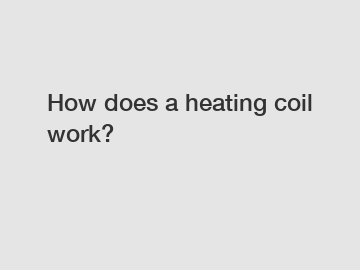How does a heating coil work?
How Does a Heating Coil Work?
In today's modern world, heating systems play a vital role in keeping our homes warm and comfortable during colder months. One of the key components of heating systems is the heating coil. Understanding how a heating coil works is essential for homeowners looking to maintain and troubleshoot their heating systems. In this blog post, we will delve deep into the inner workings of a heating coil, shedding light on its functionality and significance.
What is a Heating Coil?

A heating coil, also known as an electrical resistance heater, is a device that converts electrical energy into heat energy. It consists of a tightly wound wire made of a high-resistance material, typically nichrome (a nickel-chromium alloy). The high resistance of the wire allows for efficient conversion of electrical energy to heat, making it ideal for heating applications.
The Working Principle:
When an electric current flows through the heating coil, it encounters resistance within the wire. According to Ohm's law, as the current flows through a material with resistance, heat is generated. The tightly wound nature of the coil maximizes surface area, allowing for efficient heat transfer to the surroundings.
When the heating system is turned on, electricity is supplied to the heating coil through a circuit. The current passing through the wire encounters resistance, producing heat. The heat generated is then transferred to the air or liquid medium being heated, eventually raising its temperature.
Application in Home Heating Systems:
Heating coils are commonly found in various heating systems, including electric furnaces and baseboard heaters. In electric furnaces, the heating coil is housed within a metal chamber, across which air is forced using a fan. As the air passes over the heating coil, it gets heated before being circulated into different areas of the house through ductwork.
Similarly, baseboard heaters consist of a long, narrow heating coil enclosed by a metal cover. They are typically installed along the baseboard of a wall, and as cool air enters from the bottom, it is warmed up by the heating coil and rises, creating a convection current.
Safety Considerations:
While heating coils are efficient and reliable, safety should always be a top priority. Heating systems often incorporate safety features such as temperature limit switches and fuses to prevent overheating and electrical hazards. It is crucial to ensure that these safety mechanisms are installed properly and in good working condition.
Maintenance and Troubleshooting:
To maintain the efficiency of heating coils, regular cleaning and upkeep are necessary. Over time, dust and debris can accumulate on the coil, hindering heat transfer. Cleaning the coil using a soft brush or vacuum can help restore its performance.
However, if you notice that your heating system isn't producing enough heat or is consuming excessive electricity, it may be a sign of a faulty heating coil. In such cases, it is advisable to consult a professional technician who can diagnose and repair the issue.
Conclusion:
Heating coils are an integral part of heating systems, providing warmth and comfort to our homes. Understanding how they work and ensuring their proper maintenance is essential for optimal performance and longevity. By familiarizing ourselves with heating coil functionality, we can easily troubleshoot minor issues and appreciate the significance of these heating elements. So the next time you feel the warmth of your heating system, remember the incredible work done by the humble heating coil.
Contact us to discuss your requirements of heat treatment and induction tempering, high frequency annealing machine 40kw supplier, induction tempering machine. Our experienced sales team can help you identify the options that best suit your needs.

Comments
0